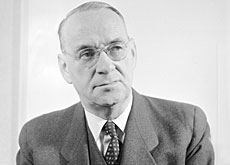Righteous Swiss who saved thousands of Jews

A Swiss diplomat credited with helping more than 60,000 Jews escape the Holocaust in German-occupied Hungary is the subject of a special exhibition in St Gallen.
Hundreds of photos, some personal, tell the story of how Carl Lutz used his courage and skills to defy the Nazi authorities during the Second World War.
The Swiss vice consul was in charge of Switzerland’s foreign interests and visas in the Hungarian capital Budapest during the war.
“He was a sensitive person with many interests, who came from a religious background,” said historian Nathalie Bodenmüller, who put together the exhibition at St Gallen’s History and Folklore Museum in eastern Switzerland.
Born in canton Appenzell in central Switzerland to Methodist parents, Lutz studied in the United States before entering the diplomatic service. In 1942 he was appointed to the Budapest post.
At that time Hungary was a relatively safe place for Jews, despite harassment and racist legislation. But Lutz was already helping Jewish children by issuing protective letters which allowed them to emigrate to the British-controlled Palestinian Territories.
Nazis
In 1944 the situation changed dramatically with the arrival of the Nazis. Hundreds of people began besieging the Swiss legation day and night looking for a way to survive, said Bodenmüller.
“This did not leave Lutz cold. He couldn’t say, ‘this is nothing to do with me’ but felt moved by the situation and wanted to help,” said the historian.
Lutz issued many more protective letters than he was allowed. They were reluctantly recognised by the Nazis.
He also added the names of letter holders onto collective passports. “It thus seemed as though these people were Swiss and under Swiss protection,” explained Bodenmüller.
The diplomat also established 76 safe houses throughout Budapest.
Lutz was greatly aided by his wife Gertrud, his employees and other neutral parties such as the Swedes, the Swiss-run International Committee of the Red Cross and the Vatican’s representative.
But he was only able to carry out his work after tough and often tricky negotiations with the German and Hungarian authorities.
Photos
Some of the photos in the exhibition are personal and show Lutz with his family, the besieged and later bombed legation, and the ruined city. The diplomat took most of them himself.
“Lutz was a keen amateur photographer. He took lots of photos of landscapes and people. They’re of good quality, but sometimes a bit out of focus, perhaps because he often had to take them quickly and was always in danger,” explained Bodenmüller.
The exhibition also includes a 1999 Swiss stamp commemorating Lutz’s work, some of his honours and a protective letter.
Personal effects are also on display, such as a camera, although it is not possible to know whether it was the one he used in Budapest.
Recognition
In total Lutz managed to save around 62,000 Jews – almost half of those who survived the German occupation in Hungary.
“People still know about Lutz in Budapest, more so than in Switzerland,” said Bodenmüller.
In 2005 a permanent exhibition about Lutz was opened in Budapest and a year later a memorial plaque was unveiled.
He has also been honoured in Israel, where he was the first Swiss to be given the title “Righteous Among the Nations” at the Yad Vashem Holocaust memorial.
But recognition was slow in his homeland. At first Lutz was reprimanded by his superiors for having overstepped his competences, but was still able to remain in the diplomatic service.
Lutz was finally honoured by the Swiss government in 1957. But he did not come back into the public eye until 1995 – 20 years after his death – when he was praised during commemorations marking the 50th anniversary of the end of the war.
swissinfo
The photo exhibition “Carl Lutz – Saving lives with visas” at St Gallen History and Folklore Museum is running until February 18, 2007.
The mobile exhibition has already been on display in Los Angeles, London, New York, Tel Aviv, Jerusalem and Basel.
It is supported by the Swiss arts council, Pro Helvetia.
Lutz was born in 1895 in Walzenhausen in canton Appenzell. His parents were Methodists.
At the age of 18 he left for the United States. From 1920 he worked for the Swiss Legation in Washington before moving on to consulates in Philadelphia and St Louis.
In 1935 he married Gertrud Fankhauser and spent time in the Palestinian Territories and Tel Aviv.
In 1942 he became head of Switzerland’s foreign interests in Budapest. He also represented the United States, Britain and ten other countries.
His protective letters saved around 62,000 Jews, but was reprimanded for his actions by the Swiss government after the war ended.
He later divorced Gertrud and married a second time. Lutz died in 1975.

In compliance with the JTI standards
More: SWI swissinfo.ch certified by the Journalism Trust Initiative

You can find an overview of ongoing debates with our journalists here. Please join us!
If you want to start a conversation about a topic raised in this article or want to report factual errors, email us at english@swissinfo.ch.